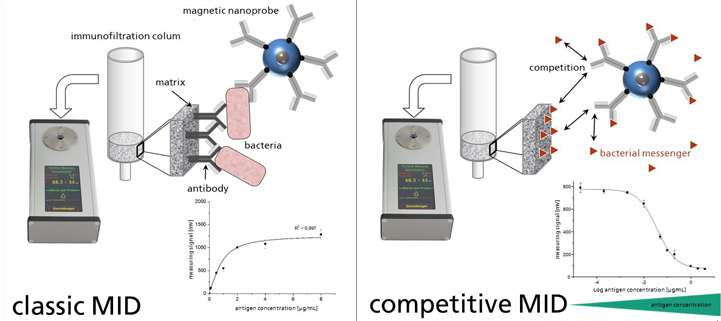Magnetic immunodetection (MID) is used to detect bacterial pathogens and toxins in water samples. To achieve this, nanoprobes coated with antibodies bind selectively to pathogens or toxins. Two different approaches are pursued for the analyses:
NANObeST - Research approach

Classic magnetic immunodetection
In the sandwich-based MID method, several antibodies can bind to, for example, one bacterium. This means that the analyte first binds to the immunofiltration column. For detection, the analyte is magnetically marked by binding an antibody-functionalized nanoprobe. The magnetic measurement signal of the preconcentration column increases according to the analyte concentration in the sample. To increase the sensitivity, an optional magnetic preconcentration can be added upstream. However, one problem with this method is that living and dead bacteria cannot be distinguished from each other. The classical approach is also not suitable for the determination of a total bacterial count, since a specific antibody would have to be present for each pathogen. This, however, is associated with considerable effort and high costs due to the large number of different pathogens that can occur in water samples.
Competitive magnetic immunodetection
To determine the total bacterial count, messenger substances of the microorganisms, so-called autoinducers, will be detected. For different classes of autoinducers, specific antibodies need to be generated. Since autoinducers are only generated by living bacteria and have a short half-life time, only living bacteria are detected, contrary to classical MID.
The autoinducers are so small that only one antibody can bind at a time. The immunofiltration column is coated with an equivalent of the analyte. The added nanoprobes can now bind either to the column or to the free analyte. If only few or no free analytes are present in the sample, a large number of nanoprobes will bind to the column and a high signal is detected. On the contrary, if the water is contaminated, numerous nanoprobes will bind to free analytes and a low signal is detected.
Magnetic multiplex detection
Multiplex detection is the simultaneous analysis of two or more pathogens in a sample. Different kinds of magnetic nanoprobes are functionalized for different analytes. The novel magnetic frequency mixing detection method is able to distinguish the magnetic "fingerprints" of the various types of magnetic particles and can consequently examine individual pathogens separately.
Instrument construction
The instruments should be in compliance with the catalogue of requirements compiled by the THW. Particular importance is attributed to intuitive usability, as many volunteers have little practice in handling the equipment. Under field conditions, well structured menu navigation, an easy-to-read display of the analysis results as well as error detection are essential. The devices have to be robust in order to withstand the adverse operating conditions in the field and still function as reliable as possible. In particular, the mobile device used for analysis directly at raw water sources must be able to withstand harsh environmental conditions.
 Fraunhofer Institute for Molecular Biology and Applied Ecology IME
Fraunhofer Institute for Molecular Biology and Applied Ecology IME
